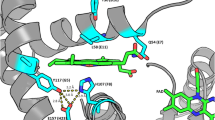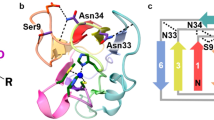Abstract
In the redox center of azurin, the Cu(II) is strongly coordinated to one thiolate S from Cys 112 and two imidazole Ns from His 46 and 117. This site yields a complex resonance Raman (RR) spectrum with >20 vibrational modes between 200 and 1500 cm–1. We have investigated the effects of ligand-selective isotope replacements on the RR spectrum of Pseudomonas aeruginosa azurin to determine the relative spectral contribution from each of the copper ligands. Growth on 34S-sulfate labels the cysteine ligand and allows the identification of a cluster of bands with Cu–S(Cys) stretching character between 370 and 430 cm–1 whose frequencies are consistent with the trigonal or distorted tetrahedral coordination in type 1 sites. In type 2 copper-cysteinate sites, the lower ν (Cu–S) frequencies between 260 and 320 cm–1 are consistent with square-planar coordination. Addition of exogenous 15N-labeled imidazole or histidine to the His117Gly mutant generates type 1 or type 2 sites, respectively. Because neither the above nor the His46Gly mutant reconstituted with 15N-imidazole exhibits significant isotope dependence, the histidine ligands can be ruled out as important contributors to the RR spectrum. Instead, a variety of evidence, including extensive isotope shifts upon global substitution with 15N, suggests that the multiple RR modes of azurin are due principally to vibrations of the cysteine ligand. These are resonance-enhanced through kinematic coupling with the Cu–S stretch in the ground state or through an excited-state A-term mechanism involving a Cu-cysteinate chromophore that extends into the peptide backbone.
Similar content being viewed by others
Author information
Authors and Affiliations
Additional information
Received: 29 July 1996 / Accepted: 9 November 1996
Rights and permissions
About this article
Cite this article
Andrew, C., Han, J., den Blaauwen, T. et al. Cysteine ligand vibrations are responsible for the complex resonance Raman spectrum of azurin. JBIC 2, 98–107 (1997). https://doi.org/10.1007/s007750050111
Issue Date:
DOI: https://doi.org/10.1007/s007750050111




